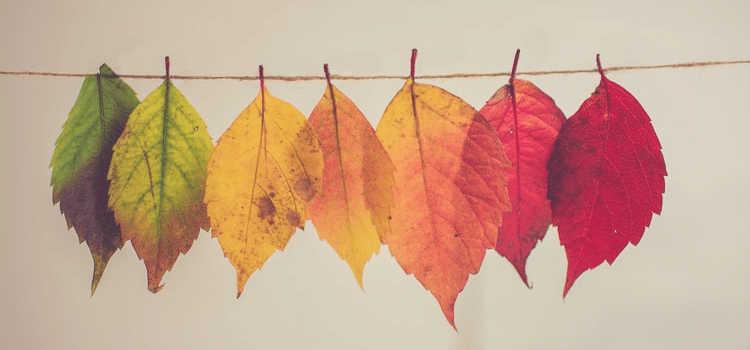It’s fall now, and you may be in one of two camps. Love it (Sweater weather! Pumpkin everything! Holiday feels!), or dread it (shorter days, colder temps, mood shifts).
If you’re in the former: congratulations, high five.
If you’re in the latter, babe, you are so not alone!

Upwards of 20% of people with depression find seasonal patterns (and corresponding seasonal blues) to it. And, the majority notice their symptoms getting worse in the fall and winter months. Further, about 5% of the entire US population experiences what we call Seasonal Affective Disorder. It’s a real deal and can feel like a pretty rotten one at that.
Your chances for seasonal blues are higher if you’re female (boo). Or, if you have a history of depression (yours or genetically) already. And if you live further from the equator (you guessed it, sun and light play a major role).
If you’ve survived one or 20 crappy winters in the past, I’m here to tell you that all is not lost! Knowing your patterns is a big part of the puzzle, because once you know you’re prone to seasonal blues, you can be proactive and start to take action early.
These tips for seasonal blues are helpful for depression and low-mood-stuff in general, but can be especially helpful in the fall and winter.
Get light
Sunshine and light therapy have been used in treated seasonal depression for decades, and with good results. The best times to get light in the winter months are in the morning hours, and you only need 15-30 minutes. If you can’t get natural sunlight really easy way to get this is to use a light box or SAD lamp; they used to be pretty pricey, but you can find really affordable ones (even travel sizes!) now.
Get moving
Exercise. Movement. Whatever you want to call it, there really is no substitute. Exercise has been proven, again and again, to have powerful mood-boosting benefits by stimulating our feel-good neurotransmitters, helping to reduce stress and sleep. Bonus if you can do this outside or with a friend, but anything is better than nothing.
Go with the flow, or against the grain
Let me explain this one a little bit. I believe there are times when we must honor where we are, even if it feels emotionally crappy. I also believe that there are times when we need to give ourselves a gentle nudge to create a shift in thoughts or feelings. How do you know what to do and when? This is probably a question only you can answer, but maybe with the help of a good friend or therapist; someone who knows you well. For example, if your tendency is to isolate and hibernate in the fall and winter, it might be helpful for you to challenge yourself to get out and do something; hang out with a pal, take a class, whatever.
If you’re more prone to pushing (ahem, ignoring) your feelings, running life at a frenzied pace to the point of breakdown and burnout, consider slowing down and hibernating a wee bit more, maybe. I am a mix of both, for sure, and my pendulum tends two swing at extremes; it’s helpful for me to keep balance in mind. Rule of thumb: if what you’re doing isn’t serving or helping you, consider making a few changes for your overall good.
Get a tune-up
I’m a therapist, so I mean, I am always going to suggest therapy, but I really mean it here. You don’t have to enter into a 3-year partnership with a counselor! I have many clients who have done incredible work and come back every now and then for what we call a “tune up.” When things feel especially tough, going through a rough patch, or even just to have someone support you til springtime – having a “seasonal” therapist can be incredibly helpful. We have tricks and tools that are for this very time of the year, and therapeutic interventions that just might help you survive (even thrive) in the winter!
Keep an eye on your food
I will discuss this in another article, but there is a strong connection between what you eat and how you feel. I am an unwavering advocate for non-restriction, and instead instead “crowding out” your plate with plenty of mood-supporting ingredients most of the time (and sometimes for me, mood-supporting = chocolate cake). The key is, most of the time, whole foods will help your mood (and anxiety) more than processed foods will. There are many reasons for this, from the nutritional components (vitamins, minerals, antioxidants) to stable blood sugar and better sleep. (However, I encourage you, if you’re someone with a history of eating disorders or getting obsessive about your food, to take caution. There are about zero mental health benefits to having disordered eating or spending 80% of your brainpower thinking about your food intake.)
Consider supplements
Lastly, talk to your doctor or healthcare professional about supplements that may be helpful. A big go-to is Vitamin D, which is low in the general population year-round (thanks to deficient diets, indoors time, and SPF), but really plummets when days are shorter. It’s best to get a blood test for this to see where your levels are and go from there (I follow functional medicine guidelines, which might be at the higher end of “normal” for your doctor.). Vitamin D is not only helpful for brighter moods, but also stronger bones, immunity, cell growth, and many other benefits.
Other supplements that may be helpful are the natural anti-depressants: omega-3 fatty acids, B-complex, St. John’s Wort, or SAM-e. I could write an entire article on these (and may do so in the future!), but please check with your doc about these last 2 especially if you are on any other anti-depressant or mood-stabilizing medication.

